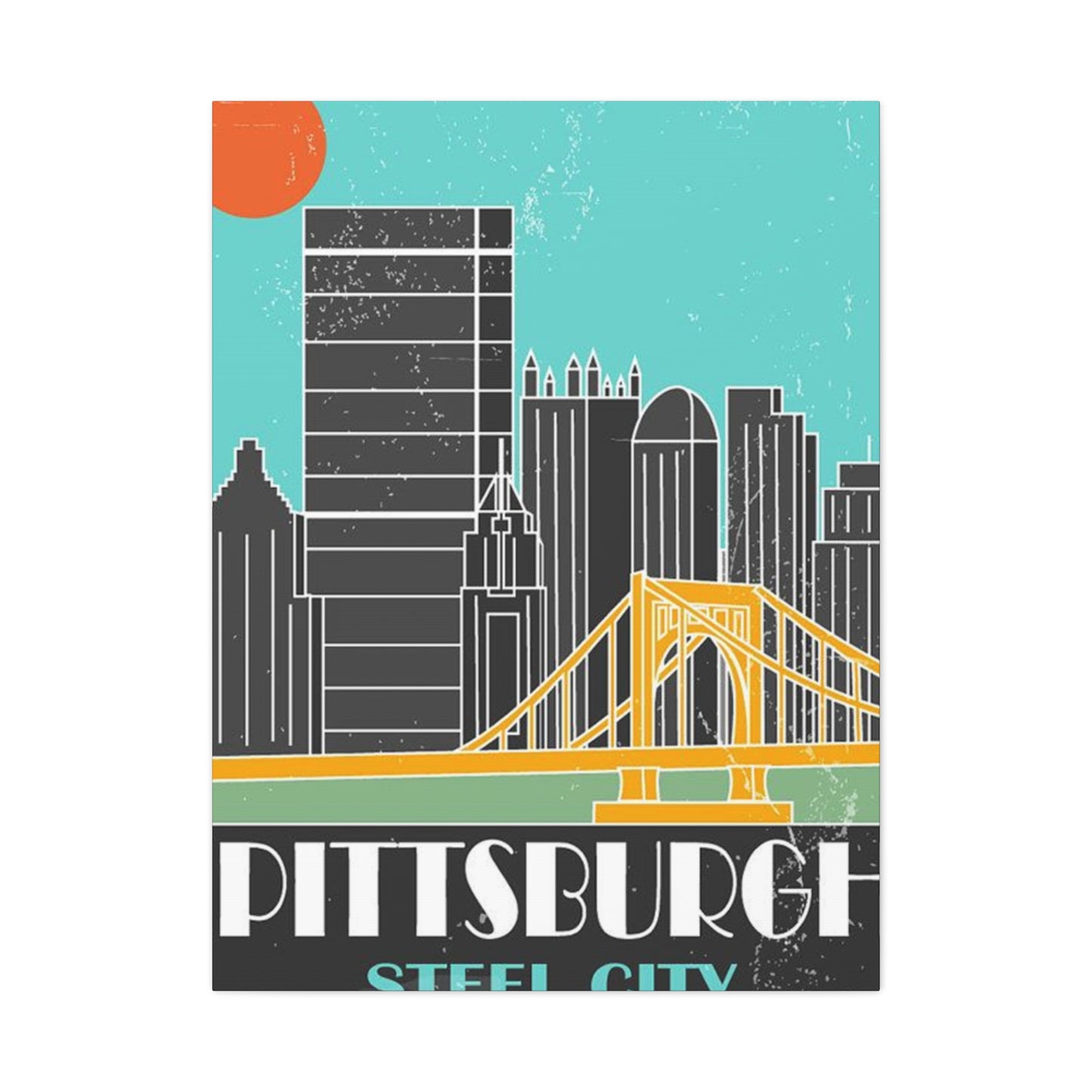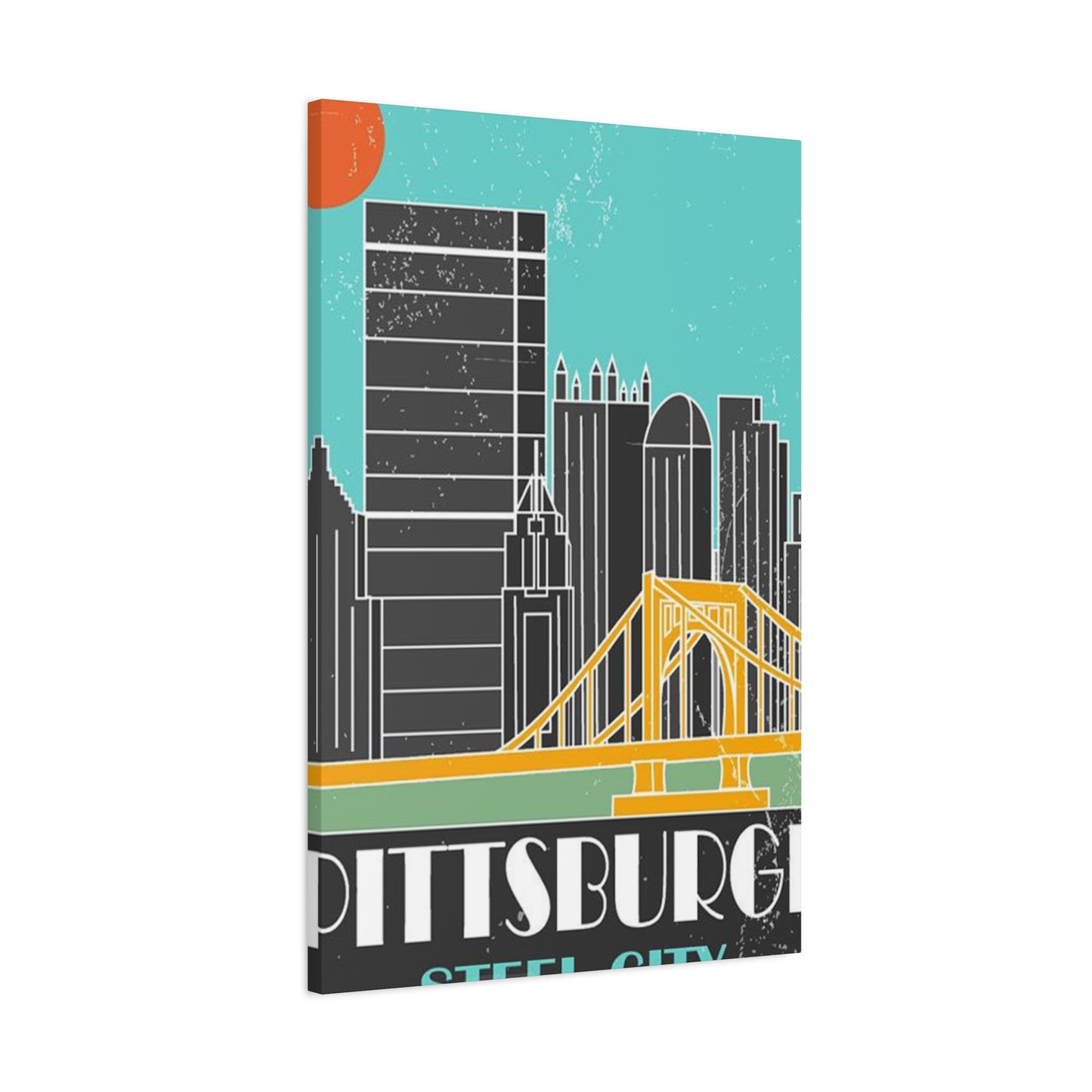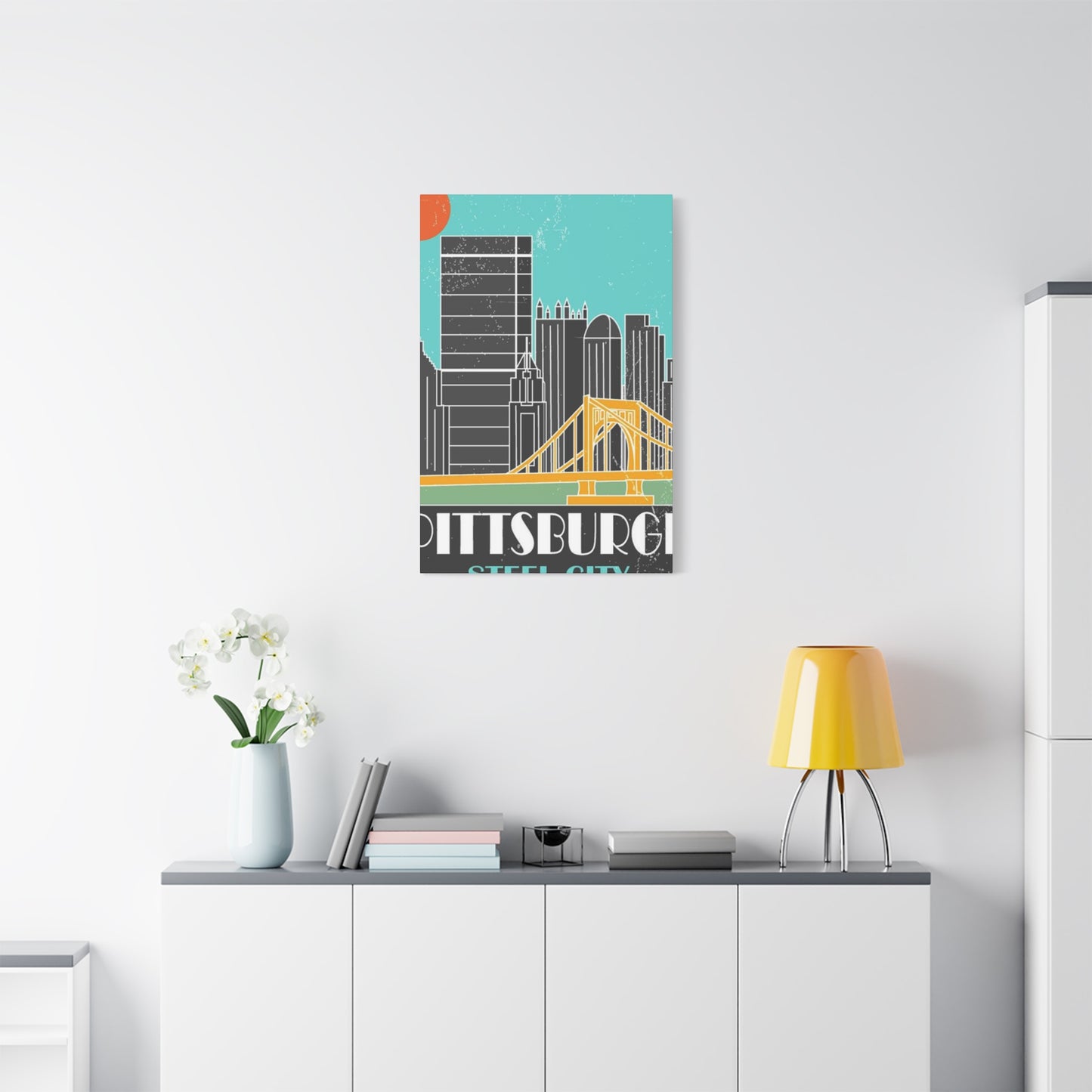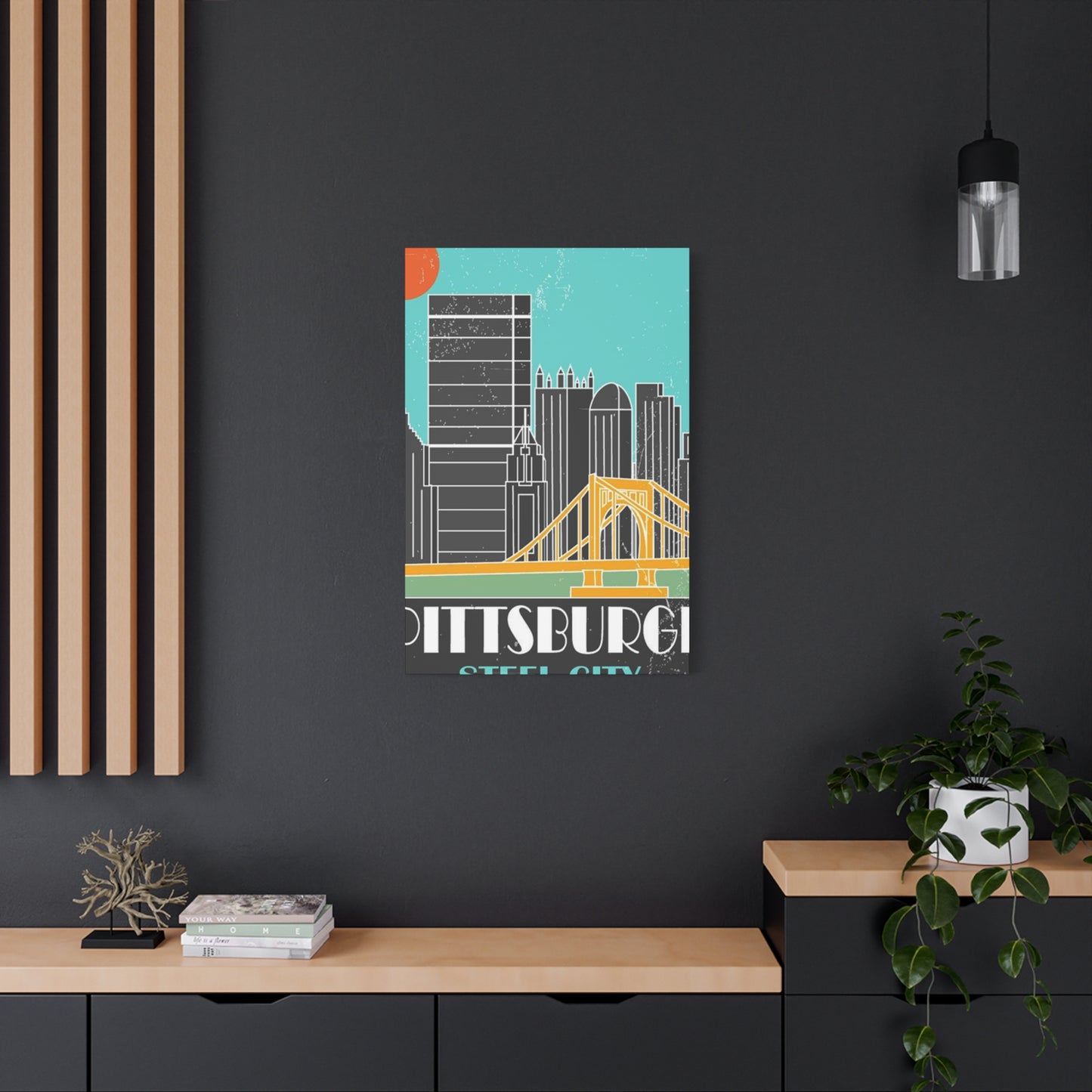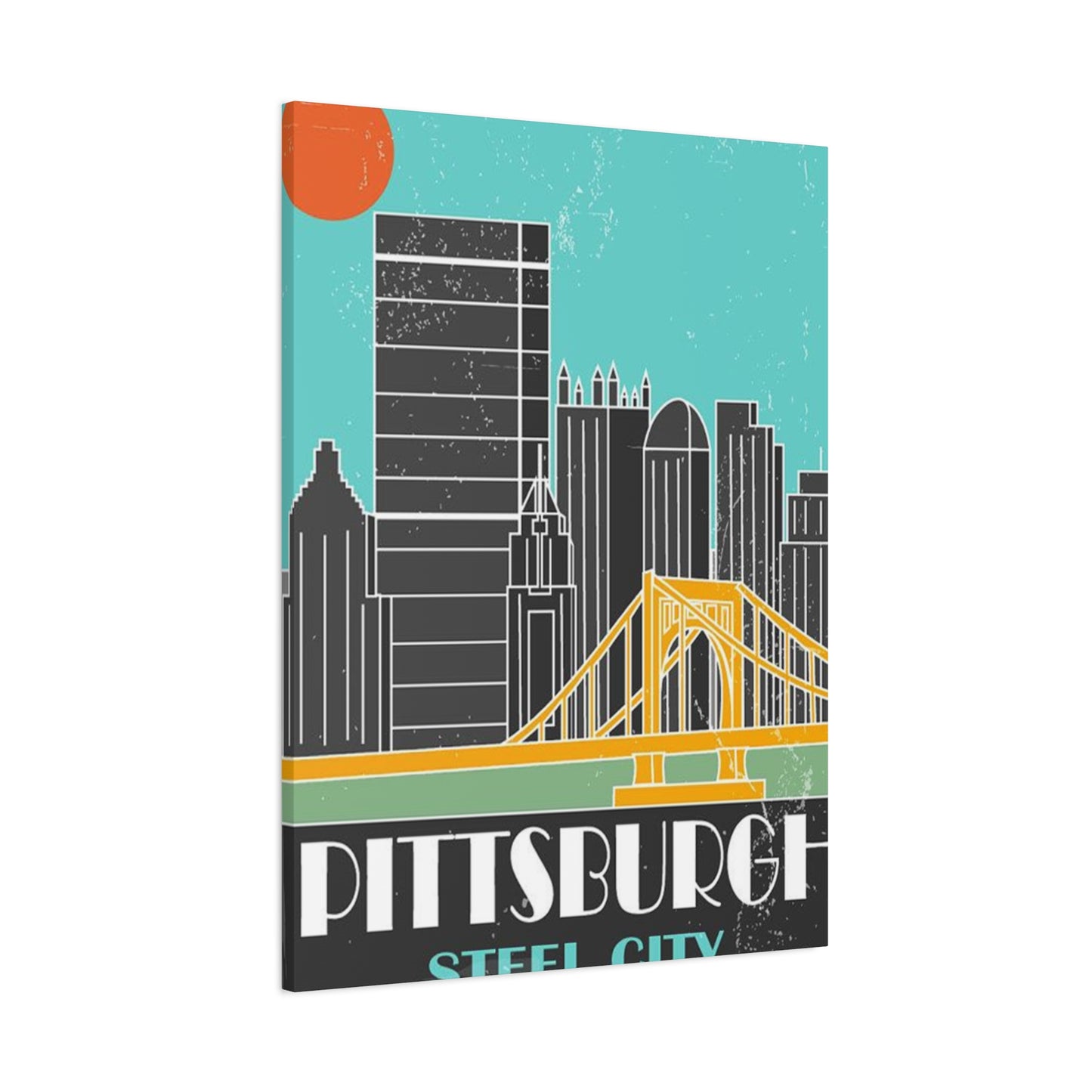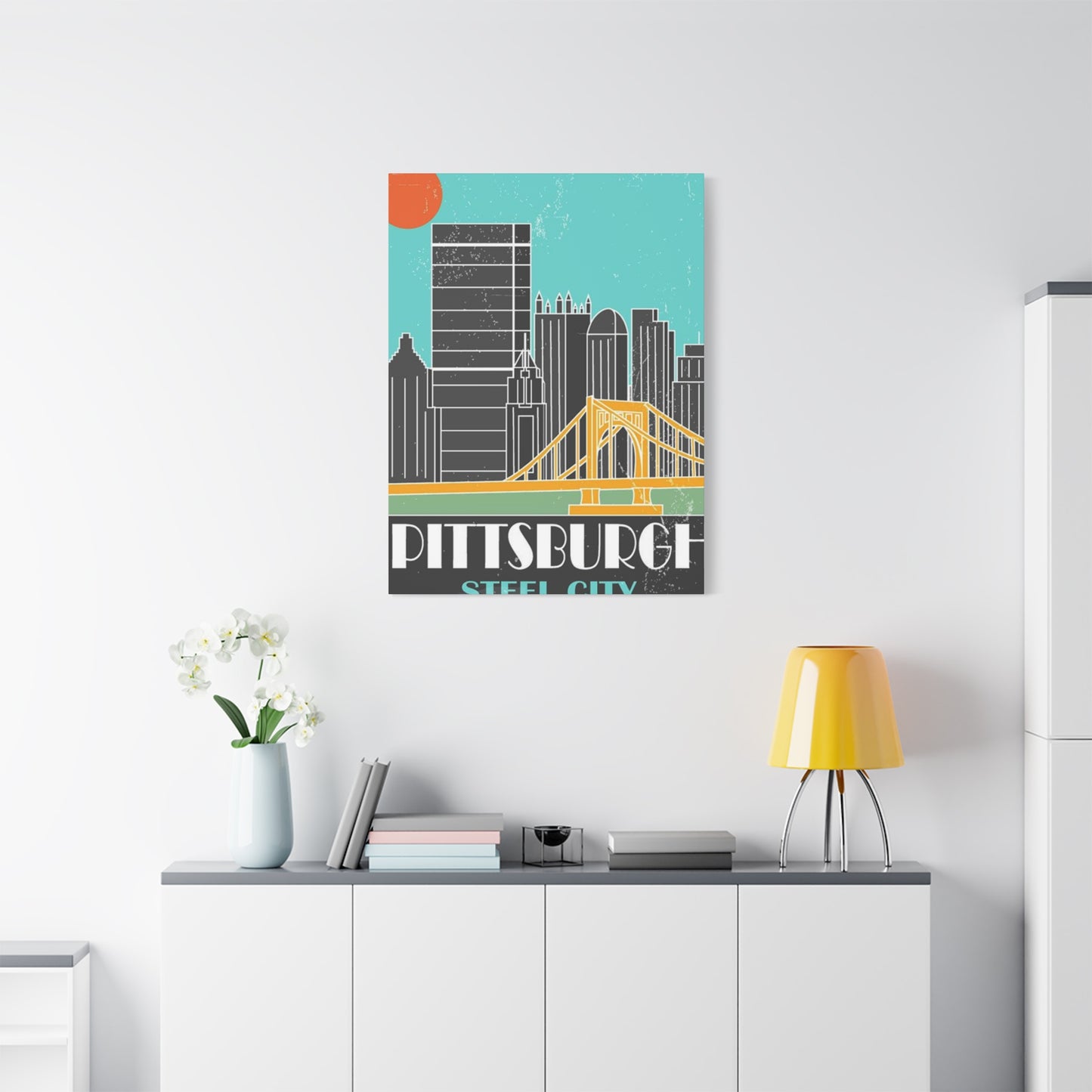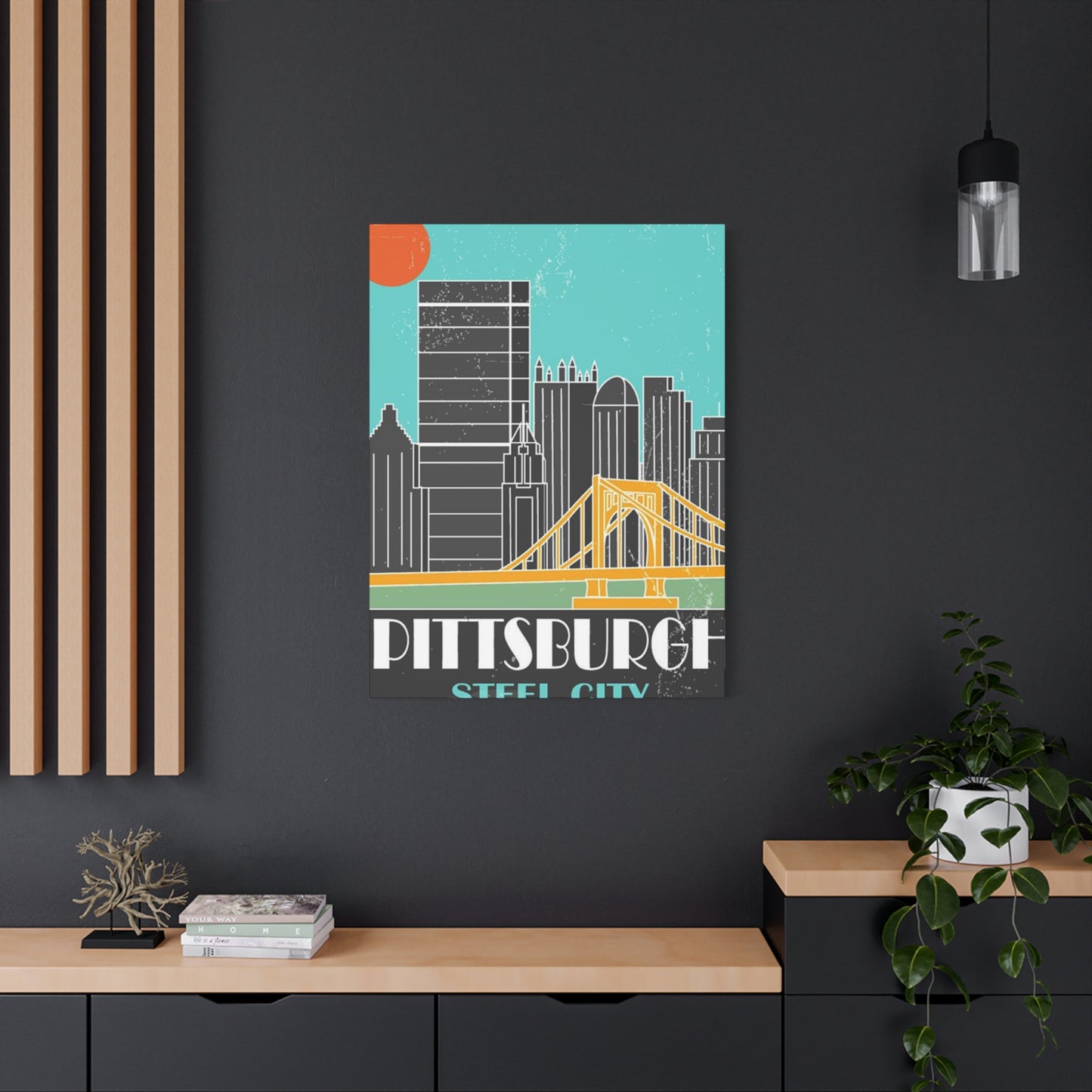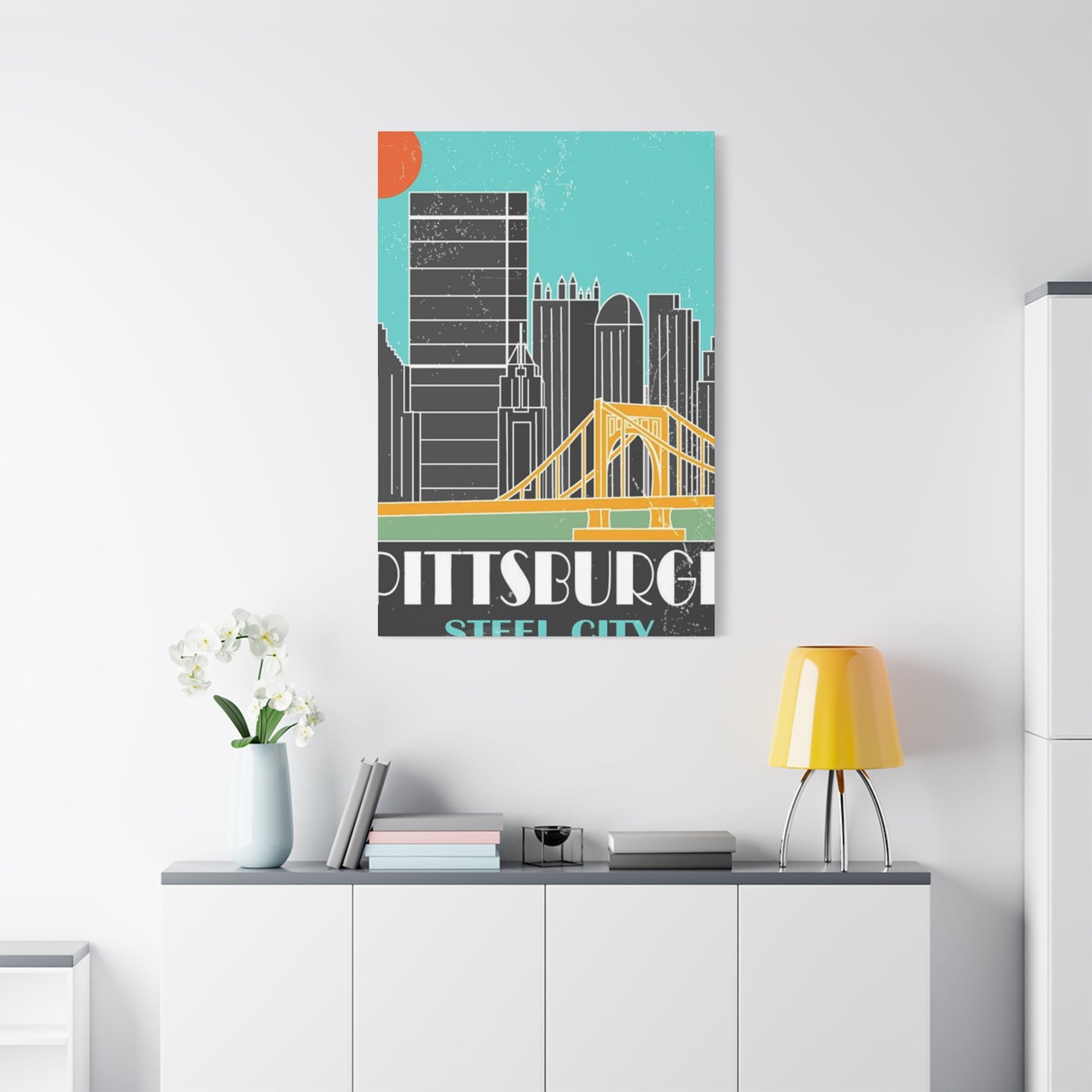Pittsburgh The Steel City Poster Wall Art: Combining Industrial Legacy with Modern Style
The industrial heritage of western Pennsylvania has created a unique aesthetic that continues to inspire artists and designers across the globe. When you explore decorative pieces that celebrate this manufacturing legacy, you discover a rich tapestry of cultural identity woven through decades of hard work and innovation. The visual representation of this era captures not just the physical structures of mills and factories, but the spirit of determination that defined an entire generation of workers and their families.
Artistic interpretations of this industrial landscape have evolved significantly over the years, moving from documentary photography to stylized illustrations that capture the essence rather than just the literal appearance of these historic locations. Contemporary creators draw inspiration from the bold lines of bridges, the geometric patterns of steel frameworks, and the interplay of light and shadow that characterized the working environment of heavy industry. These visual elements translate beautifully into home decor, offering a sophisticated blend of nostalgia and modern design sensibility.
The appeal of industrial-themed decorative pieces extends far beyond those who have personal connections to manufacturing history. Design enthusiasts appreciate the strong visual composition, the limited color palettes that often feature blacks, grays, and warm amber tones, and the way these pieces can anchor a room with their bold presence. Whether you're furnishing a modern loft, a traditional home office, or a casual entertainment space, artwork celebrating industrial heritage provides a conversation-starting focal point that combines historical significance with contemporary style.
Exploring Different Artistic Styles for Industrial City Decor
The range of artistic interpretations available for industrial city themed decorations spans from photorealistic renderings to highly abstract geometric compositions. Vintage photography styles often employ sepia tones or black and white treatments that evoke the documentary images from the early twentieth century, when photographers first began capturing the dramatic scale of industrial operations. These pieces carry an authentic historical weight that appeals to collectors and history enthusiasts who value accurate representation of the past.
Illustrated approaches offer more creative freedom, allowing artists to emphasize certain architectural elements while simplifying or stylizing others. Line art representations can highlight the elegant engineering of suspension bridges, the rhythmic repetition of industrial windows, or the dramatic silhouettes of blast furnaces against evening skies. These minimalist interpretations work particularly well in contemporary spaces where clean lines and uncluttered visual statements are preferred.
Watercolor treatments bring a softer, more romantic quality to industrial subjects, which might seem contradictory but actually creates a compelling visual tension. The fluidity of watercolor techniques can suggest the smoke and steam that once filled industrial valleys, while also lending an artistic legitimacy that elevates the subject matter beyond mere documentation. Oil painting styles, whether traditional or digital, allow for rich texture and depth that can capture the play of firelight on metal surfaces or the atmospheric perspective of sprawling industrial complexes.
Abstract interpretations take elements from industrial architecture and break them down into pure form and color studies. Geometric patterns derived from structural steel, color palettes extracted from rust and oxidation, and compositions inspired by the layered complexity of machinery all contribute to artwork that references industrial heritage without literally depicting it. These pieces appeal to viewers who want to acknowledge the cultural significance of manufacturing history while maintaining a thoroughly modern aesthetic in their living spaces.
Selecting the Perfect Size for Your Display Space
Determining the appropriate dimensions for decorative pieces requires careful consideration of both the wall space available and the viewing distance from which the artwork will typically be seen. For living rooms and primary gathering spaces, larger formats create dramatic impact and serve as anchor points for furniture arrangements and overall room design. A substantial piece measuring four feet or more in width can command attention above a sofa or fireplace, establishing itself as the visual centerpiece of the space.
Medium-sized options work beautifully in secondary spaces such as hallways, dining areas, or home offices where you want visual interest without overwhelming the room's other elements. These versatile dimensions typically range from two to three feet in either direction, providing enough presence to be noticed and appreciated while leaving room for other decorative elements or furniture to share the space. They also work well as part of gallery wall arrangements where multiple pieces of varying sizes create a cohesive but dynamic display.
Smaller formats offer flexibility for tight spaces, grouped arrangements, or locations where you want a subtle reference to industrial themes without making it the dominant design element. Compact pieces measuring eighteen inches or less can be positioned on shelves, incorporated into desk areas, or used to fill awkward wall spaces that larger formats couldn't accommodate. They also serve well as companion pieces to larger artwork, creating visual rhythm and preventing single large pieces from appearing isolated on expansive walls.
When planning your display, consider the standard viewing distance guideline where viewers should ideally stand back about one and a half times the width of the artwork to appreciate its full composition. This means a four-foot wide piece needs at least six feet of viewing distance to be properly appreciated, which influences whether it belongs in a spacious living area or might be too large for a narrow hallway. Taking actual measurements of your wall space and considering furniture placement ensures you select dimensions that enhance rather than crowd your environment.
Choosing Between Different Printing Methods and Materials
The substrate on which artwork is printed significantly impacts both its visual characteristics and longevity. Premium paper options provide rich color saturation and fine detail reproduction that closely resembles original artwork, making them popular choices for pieces that will be framed behind glass. Archival quality papers resist fading and deterioration when properly displayed away from direct sunlight, maintaining their appearance for decades with minimal care required.
Canvas prints offer a more casual, contemporary presentation that doesn't require framing, as the printed image typically wraps around the edges of a wooden stretcher frame. This gallery-wrap technique creates a finished look straight out of the box, making canvas an economical choice for those who want immediate display without the additional expense of custom framing. The texture of canvas adds a painterly quality to images, which works particularly well with illustrated or painted original artwork but can be less ideal for photographic images where fine detail is important.
Metal printing represents a modern technology where images are infused directly into specially coated aluminum sheets, creating a luminous quality and exceptional durability. The metallic surface adds a contemporary industrial feel that seems particularly appropriate for artwork celebrating manufacturing heritage. These prints resist moisture and fading while requiring no frame or glass, though they do need appropriate mounting hardware to support their weight. The reflective quality of metal can be striking but requires careful consideration of room lighting to avoid unwanted glare.
Acrylic face mounting involves printing on paper or film and then mounting it behind clear acrylic sheets, creating depth and a high-gloss finish that intensifies colors and adds a gallery-quality presentation. This premium option provides museum-level protection for the printed image while creating a contemporary look that suits modern interiors. The thickness and weight of acrylic pieces require sturdy mounting solutions, and the glossy surface may reflect light sources in your room, considerations that should influence placement decisions.
Framing Options That Enhance Industrial Aesthetics
The frame you select serves both practical and aesthetic functions, protecting the artwork while either complementing or contrasting with its visual style. For industrial-themed pieces, simple black frames provide a classic choice that echoes the ironwork and machinery of manufacturing environments without competing with the artwork for attention. Clean lines and minimal ornamentation in frame design keep the focus on the image while providing a finished, gallery-ready appearance that suits most interior styles.
Natural wood frames in darker tones like walnut or espresso create warmth while still maintaining the substantial presence that industrial artwork demands. Wood introduces an organic element that can soften the harder edges of industrial imagery, creating balance in spaces that might otherwise feel too austere. The grain and texture of wood add visual interest without overwhelming the primary subject, and wood frames often feel more residential and less institutional than some metal alternatives.
Metal frames fabricated from aluminum or steel provide the most literal connection to industrial subject matter, with their material composition directly referencing the manufacturing heritage depicted in the artwork. Brushed or matte finishes prevent excessive reflection while maintaining a contemporary appearance that works well in modern spaces. Steel frames carry more visual weight than aluminum, making them appropriate for larger pieces or situations where you want the frame itself to make a statement.
Floating frames create a contemporary presentation where a small gap appears between the artwork and the frame, giving the impression that the piece hovers within its border. This style works particularly well with canvas or metal prints where the image wraps around the edges, as the floating presentation allows those wrapped edges to remain visible and contribute to the overall aesthetic. The dimensional quality created by floating frames adds sophistication and suits gallery walls or featured display areas where you want artwork to feel important and intentional.
Color Palette Considerations for Room Coordination
Industrial heritage artwork typically employs color schemes dominated by neutrals, metallic tones, and earth colors that reflect the materials and environments of manufacturing operations. Deep grays and charcoal blacks reference the iron and steel that formed the foundation of industry, while warm amber and orange tones recall the dramatic firelight of furnaces and molten metal. These naturally compatible colors make industrial artwork surprisingly versatile, as they coordinate with a wide range of interior color schemes without clashing or competing.
When your existing decor features cool tones like blues, grays, and whites, industrial artwork integrates seamlessly while adding depth and visual weight that prevents spaces from feeling too sterile or cold. The darker elements in the artwork ground lighter color schemes, providing contrast that makes both the walls and the artwork more visually interesting. This combination works particularly well in modern and contemporary interiors where clean lines and minimal color palettes dominate.
Warmer interior palettes featuring beiges, tans, and earth tones gain richness and sophistication when paired with industrial imagery. The combination creates a balanced environment that feels both comfortable and cultured, suitable for traditional homes that want to incorporate contemporary art or contemporary spaces that want to avoid feeling too stark. The warmth in both the environment and the artwork creates cohesion while the subject matter adds an unexpected edge that keeps the design from feeling predictable.
For bolder interior schemes incorporating accent colors like deep reds, burnt oranges, or forest greens, industrial artwork serves as a neutral anchor that allows those brighter hues to shine without creating visual chaos. The predominantly neutral palette in the artwork provides visual rest points that prevent colorful rooms from becoming overwhelming, while the subject matter adds enough interest to avoid feeling like a default neutral choice. This approach allows you to change accent colors seasonally or as tastes evolve without needing to replace coordinating artwork.
Incorporating Multiple Pieces into Gallery Wall Arrangements
Creating a cohesive gallery wall with multiple pieces requires planning both the overall composition and the relationships between individual elements. Starting with a primary anchor piece, typically the largest or most visually striking item in your collection, establishes a focal point around which other pieces can be arranged. This anchor often works best positioned slightly off-center rather than in the geometric middle of the arrangement, creating a more organic and visually interesting composition than perfectly symmetrical layouts.
Mixing different sizes creates visual rhythm and prevents gallery walls from appearing static or monotonous. Alternating between larger and smaller pieces guides the eye around the arrangement, encouraging viewers to examine each element rather than seeing the collection as an undifferentiated mass. When working with industrial themes, you might include a large bridge illustration as your anchor, surrounded by smaller photographs of architectural details, abstract pieces derived from industrial patterns, and perhaps vintage typography or signage that references the era.
Maintaining consistent spacing between pieces creates professional polish that elevates even modest artwork into impressive displays. Most designers recommend spacing pieces two to three inches apart, measuring from frame edge to frame edge, which provides enough separation to let each piece maintain its individual identity while keeping the collection unified as a single installation. Using paper templates cut to the size of each frame lets you experiment with arrangements before putting holes in walls, a planning step that prevents frustration and unnecessary damage.
Color and style consistency across the collection ensures that gallery walls feel intentional rather than random. This doesn't mean every piece must be identical, but there should be unifying elements whether through shared color palettes, similar subject matter, complementary artistic styles, or coordinating frame choices. For industrial themes, you might use all black and white photography, or mix color and monochrome pieces but maintain industrial subject matter throughout, or vary subjects slightly but keep all frames in matching black metal to tie everything together.
Lighting Techniques to Showcase Your Display
Proper illumination transforms artwork from decorative background elements into featured attractions that command attention and reveal details that might otherwise go unnoticed. Picture lights mounted directly above frames cast focused illumination that highlights the artwork without spilling excessive light into the surrounding room, creating drama and emphasis. These fixtures work best for traditionally framed pieces where the light can be positioned to avoid glare on glass while fully illuminating the printed surface.
Track lighting offers flexibility, allowing you to adjust individual fixtures to properly illuminate multiple pieces or to accommodate changes in your display over time. Directional heads on track systems let you fine-tune the angle and focus of each light source, which is particularly important when working with reflective surfaces like glass, acrylic, or metal prints that can create distracting glare if lighting isn't carefully positioned. The linear arrangement of track lighting suits gallery wall installations where multiple pieces need individual attention.
Recessed ceiling lights create a clean, minimalist look that suits contemporary interiors while still providing the directional lighting artwork needs for proper display. Adjustable trim options allow these built-in fixtures to angle toward walls, and narrow beam spreads concentrate light on artwork rather than washing entire walls. This approach requires more planning during installation but creates a seamless, architectural quality that eliminates visible fixtures from your design scheme.
Natural lighting can beautifully illuminate artwork but requires careful management to prevent damage from ultraviolet radiation and excessive heat. Position pieces on walls that receive indirect rather than direct sunlight, and consider UV-filtering window treatments or glazing that blocks harmful radiation while allowing visible light to pass through. The changing quality of natural light throughout the day adds life to static images, with different times revealing different aspects of the artwork's composition and detail.
Understanding Print Quality and Resolution Requirements
The technical specifications of digital prints directly impact their visual quality and appropriate viewing distances. Resolution, measured in dots per inch, determines how much detail the print can reproduce and how close viewers can examine it before individual pixels become visible. Professional quality prints typically require 300 DPI at the final print size, meaning a two-foot wide print needs a digital file that's 7200 pixels wide to maintain excellent detail and sharpness.
Viewing distance somewhat mitigates resolution requirements, as prints intended for viewing from across a room don't need the same pixel density as pieces that will be examined up close. This is why billboard images can be printed at much lower resolutions than photographs in books, because the viewing distance increases proportionally. For home decor, where viewers typically stand anywhere from a few feet to across the room, resolution becomes less critical than for pieces that will hang in hallways or other locations where close inspection is inevitable.
Color management ensures that prints accurately reproduce the artist's intended palette and that colors appear consistent when viewed under different lighting conditions. Professional printing services use calibrated equipment and standardized color spaces to achieve predictable results, while consumer-grade printing may show significant variation from screen to print or between different print runs. For industrial themed artwork where authenticity and mood depend heavily on accurate representation of grays, blacks, and warm metallic tones, proper color management becomes particularly important.
Print longevity depends on the combination of inks, substrates, and display conditions, with archival quality materials and proper care enabling prints to last decades without noticeable fading or deterioration. Pigment-based inks generally outlast dye-based alternatives, and papers or canvases with acid-free composition resist yellowing and brittleness. Displaying prints away from direct sunlight, high humidity, and extreme temperatures preserves their appearance, while proper framing with UV-filtering glazing provides additional protection for valuable or sentimental pieces.
Exploring Historical Photography as Decorative Elements
Authentic documentary photographs from the industrial era carry a powerful historical weight that connects viewers to the lived experiences of previous generations. These images often captured not just the physical infrastructure of manufacturing but also the workers who operated within those environments, providing human scale and emotional resonance that pure architectural photography lacks. When displayed as home decor, these historical photographs serve an educational function while also providing the aesthetic benefits of strong composition and compelling subject matter.
The technical characteristics of early photography contribute to the distinctive look that makes historical images so appealing in contemporary settings. Large format cameras produced exceptional detail and tonal range, while the slower film speeds of the era meant photographers had to carefully compose and wait for decisive moments rather than shooting rapid sequences. These technical constraints often resulted in more thoughtful, deliberate compositions that translate beautifully to wall display even a century after their creation.
Copyright and reproduction rights for historical photographs can be complex, as age alone doesn't necessarily place images in the public domain. Many historical photographs remain protected by copyright held by photographers' estates, museums, or archives that have acquired collections. However, numerous repositories make historical images available for personal use, either as public domain resources or through licensing arrangements that allow reproduction for decorative purposes. Researching the provenance and rights status of historical images ensures you're respecting intellectual property while incorporating authentic historical content into your decor.
Restoration and enhancement of historical photographs requires a delicate balance between improving print quality and maintaining authentic character. Modern digital tools can repair damage, enhance contrast, and improve sharpness, but excessive manipulation can strip away the qualities that make historical photographs distinctive. Light retouching that preserves the original tonal qualities and natural grain structure maintains authenticity while producing prints that display beautifully in contemporary homes.
Contemporary Artistic Interpretations of Industrial Heritage
Modern artists continue to find inspiration in industrial landscapes, creating new works that reinterpret traditional manufacturing imagery through contemporary perspectives and techniques. These pieces often take more liberties with representation, emphasizing mood, composition, and conceptual content over documentary accuracy. Digital illustration tools enable artists to create stylized versions of industrial scenes with precise control over every element, from color palette to level of detail, resulting in artwork that's optimized for decorative impact rather than historical documentation.
Vector illustration techniques produce clean, simplified representations of industrial subjects that work particularly well in modern interiors. The flat colors and crisp edges characteristic of vector art complement contemporary design aesthetics while the industrial subject matter adds depth and cultural reference that prevents spaces from feeling generic or impersonal. These pieces often employ limited color palettes and strong geometric compositions that make them versatile choices for a range of interior styles.
Mixed media approaches combine photography, illustration, texture, and typography to create layered compositions that reference industrial heritage while clearly announcing themselves as contemporary artistic creations. These pieces might overlay architectural blueprints with photographic elements, incorporate vintage typography and graphic design motifs, or add abstract elements derived from industrial patterns and forms. The complexity and depth of mixed media work creates visual interest that rewards repeated viewing as different layers reveal themselves over time.
Impressionistic and expressive interpretations capture the emotional essence of industrial environments rather than their literal appearance. Loose brushwork, exaggerated colors, or abstract elements convey the heat, noise, energy, and human drama of manufacturing settings in ways that purely representational work cannot. These pieces appeal to viewers who want to acknowledge industrial heritage without feeling constrained by historical accuracy or documentary aesthetics, offering instead a more personal, interpretive connection to the subject matter.
Installation Hardware and Techniques for Different Wall Types
Successfully mounting artwork requires appropriate hardware and techniques matched to both the weight of the piece and the composition of your walls. Drywall, the most common interior wall surface, requires special anchors or wall studs for secure mounting of anything beyond the lightest frames. Hollow wall anchors expand behind the drywall surface when tightened, distributing weight across a larger area and preventing screws from pulling through. For heavier pieces, locating wall studs with a stud finder and driving screws directly into these solid wood members provides maximum support.
Plaster walls, common in older construction, present different challenges as they're harder but also more brittle than drywall. Traditional picture hooks designed for plaster drive hardened nails at an angle that supports substantial weight, while plastic anchors designed for drywall often crack plaster when driven. Pre-drilling pilot holes prevents cracking and makes installation easier, though you'll need masonry bits if you encounter the wood lath that typically backs plaster walls.
Brick and concrete walls require masonry anchors and appropriate drill bits, as standard wall anchors designed for drywall have no purchase in these dense materials. Plastic sleeve anchors expand when screws are driven into them, gripping the sides of holes drilled into masonry. For maximum security with heavy pieces, lead anchors or expansion bolts provide tremendous holding power, though they also create larger holes that become more noticeable if you later remove the artwork and choose not to remount something in the same location.
Wire hanging systems offer flexibility for renters or anyone who wants to easily rearrange artwork without creating multiple holes. These systems mount from crown molding or ceiling and use nearly invisible cables to suspend frames at adjustable heights. While more expensive initially than traditional picture hangers, wire systems allow unlimited rearrangement and adjustment without any additional wall damage. The slight forward angle at which suspended frames hang can reduce glare from ceiling lights, an incidental benefit that's particularly welcome with glazed frames.
Maintenance and Care for Long-Lasting Display Quality
Regular dusting prevents accumulation of particles that can gradually degrade artwork's appearance or even cause physical damage over time. Soft, dry microfiber cloths remove dust from frames and glazing without scratching, while minimal pressure prevents flexing or stressing mounting systems. For unframed canvas pieces, very gentle dusting with soft brushes helps maintain appearance without risking damage to the canvas weave or printed surface. Establishing a routine of monthly dusting keeps artwork looking fresh and prevents the need for more aggressive cleaning that carries greater risk.
Controlling environmental conditions preserves artwork by minimizing the physical stresses that cause deterioration. Stable temperature and humidity levels prevent the expansion and contraction cycles that can cause prints to buckle, canvases to sag, and frames to separate at corners. Indoor environments naturally fluctuate less than outdoor conditions, but rooms with poor climate control or those subject to extreme seasonal variations may benefit from supplemental humidity control during dry winter months or dehumidification during humid summers.
Ultraviolet radiation from sunlight and some artificial sources causes fading and discoloration over time, with some colors and materials more vulnerable than others. UV-filtering glazing blocks most harmful radiation while remaining transparent to visible light, providing protection without noticeably changing the artwork's appearance. For pieces displayed in sunny rooms, UV filtering becomes particularly important for preservation. Alternatively, displaying particularly vulnerable pieces on walls that don't receive direct sunlight provides protection through positioning rather than special glazing.
Periodic inspection catches developing problems before they cause significant damage, allowing for timely intervention that preserves artwork's condition. Check mounting hardware annually to ensure screws remain tight and hangers remain properly engaged, as vibrations from doors closing or environmental factors can gradually loosen connections. Examine the artwork itself for any signs of fading, discoloration, buckling, or separation of layers, which might indicate environmental problems that need addressing or that the piece needs professional conservation attention.
Creating Thematic Consistency Throughout Your Home
Developing a coherent decorative theme that spans multiple rooms creates visual harmony and makes your home feel intentionally designed rather than randomly furnished. Industrial heritage artwork can serve as the unifying element, with variations in style, scale, and specific subjects keeping individual rooms distinct while maintaining overall consistency. A cohesive approach doesn't mean every room must look identical, but rather that someone moving through your home recognizes recurring elements and aesthetics that tie the spaces together.
In living and entertaining spaces, larger, more dramatic pieces serve as conversation starters and establish the industrial theme prominently. These public areas can accommodate bold statements and eclectic groupings that might feel overwhelming in more intimate spaces. Gallery walls incorporating multiple related pieces create visual impact while allowing for variety in composition and subject matter. The casual nature of living areas also permits more experimental arrangements and combinations that would seem inappropriate in formal settings.
Bedrooms and private spaces benefit from more subtle, refined applications of industrial themes that create interest without stimulating energy when rest is desired. Smaller pieces, quieter compositions, and more abstract interpretations maintain thematic consistency while moderating intensity. Black and white photography or minimalist line art versions of industrial subjects work particularly well in restrooms, where strong visual statements might feel jarring. The goal in private spaces is acknowledging the theme without making it dominant.
Transitional spaces like hallways, stairwells, and entryways offer opportunities to use industrial artwork as wayfinding and visual connection between distinct areas. A series of smaller pieces installed along a hallway creates rhythm and guides movement while maintaining visual interest in spaces that might otherwise feel neglected. Stairwell walls accommodate vertical arrangements that can incorporate numerous pieces without crowding, effectively creating an ongoing exhibition that unfolds as you move between floors.
Budget-Friendly Approaches to Quality Display
Building an impressive collection of industrial artwork doesn't require unlimited resources when you approach acquisition and display strategically. Reproduction prints of public domain historical photographs cost far less than original art or limited editions while still providing authentic historical content and strong visual appeal. Many cultural institutions make high-resolution scans of their collections available for personal use, allowing you to produce your own prints through local or online printing services at a fraction of gallery prices.
Digital marketplaces connect independent artists with buyers, eliminating gallery markups while providing artists with a larger share of sales revenue. These platforms offer industrial themed artwork in countless styles at prices accessible to most budgets, with many artists offering multiple price points for different sizes or formats of the same image. Supporting independent creators provides you with unique artwork while helping artists sustain their creative practices, a mutually beneficial arrangement that feels more personally meaningful than purchasing mass-produced commercial decor.
Do-it-yourself framing reduces costs substantially compared to custom framing services while still producing professional results with some care and effort. Standard sizes benefit from the economy of mass production, with ready-made frames costing a fraction of custom work. Matboard, glazing, and backing materials are available through craft suppliers, allowing you to assemble the complete package yourself. Online tutorials and videos make learning basic framing techniques accessible even for those with minimal prior experience, and the necessary tools represent a modest investment that pays dividends over multiple framing projects.
Strategic timing of purchases takes advantage of seasonal sales, promotional events, and clearance opportunities. Many retailers offer significant discounts during traditional sale periods like end-of-year holidays, back-to-school season, or inventory clearance events. Watching for these opportunities and planning purchases accordingly can reduce costs substantially. Additionally, purchasing multiple pieces from the same artist or seller often qualifies for volume discounts, making it economical to build collections rather than buying single pieces at full retail prices.
Understanding the Psychology of Industrial Aesthetics
The enduring appeal of industrial imagery in home decor reflects deeper psychological connections to authenticity, craftsmanship, and human achievement. In an era dominated by digital technologies and service economies, physical manufacturing represents tangible creation that produces concrete results. Decorating with industrial themes allows people to surround themselves with reminders of human capability and determination, qualities that resonate regardless of personal connection to manufacturing industries.
The raw, unfinished aesthetic associated with industrial design creates an intentional contrast with increasingly virtual and ephemeral aspects of contemporary life. Exposed materials, visible structure, and honest expression of function appeal to those seeking authenticity in their environments. Industrial artwork brings these qualities into homes through visual representation, allowing people to incorporate industrial aesthetics even in polished, finished spaces where actual exposed structure might not be practical or desired.
Nostalgia plays a significant role in the popularity of industrial themes, particularly among those whose families or communities have manufacturing heritage. These images serve as connections to personal and cultural history, honoring previous generations and their contributions. Even those without direct family connections to industry often feel drawn to the romance of a seemingly simpler era when work was physical, products were tangible, and communities were built around shared labor and common purpose.
The dramatic visual qualities of industrial subjects provide inherent aesthetic appeal beyond their symbolic content. The interplay of light and shadow in architectural photography, the geometric precision of structural steel, the dynamic movement suggested by machinery and infrastructure all create compelling compositions that satisfy fundamental aesthetic preferences. Strong horizontals and verticals create stability, diagonal elements suggest movement and energy, and the repetition of similar forms creates rhythm and visual interest that makes industrial imagery endlessly fascinating to view.
Regional Variations in Industrial Heritage Representation
Different manufacturing regions developed distinct visual characteristics based on their primary industries, geography, and architectural traditions. The steel producing regions of western Pennsylvania created landscapes dominated by massive integrated mills, blast furnaces, and the infrastructure required to move raw materials and finished products. The scale and drama of these facilities differ markedly from the textile mills of New England or the automotive plants of the Midwest, giving each region's industrial heritage a distinctive visual signature.
Architectural styles reflected both functional requirements and regional building traditions, creating additional variation in industrial aesthetics. Brick construction predominated in areas with strong masonry traditions and local clay resources, while regions with timber industries incorporated more wood elements. The climate influenced design as well, with northern facilities built more compactly to conserve heat while southern operations often featured more open structures to improve ventilation. These regional differences mean industrial artwork carries geographic signatures that can strengthen sense of place in your decor.
The social and cultural context surrounding different industries influenced how workers and communities are represented in industrial imagery. Some regions developed strong photographic traditions documenting workers' lives and community experiences, creating rich archives of human-centered industrial photography. Others focused more on architectural and technological documentation, producing images that emphasize structures and processes over people. Understanding these different approaches helps you select artwork that aligns with your interests in either human stories or technological achievement.
Contemporary reinterpretation of regional industrial heritage by local artists creates ongoing evolution of industrial aesthetics. Artists working in former manufacturing centers often bring personal connections and deep knowledge to their work, creating pieces that resonate with authentic detail and emotional truth. Supporting regional artists working with local industrial themes strengthens cultural connections while acquiring artwork with genuine ties to the places and histories it represents.
Combining Industrial Artwork with Other Decorative Elements
Successfully integrating industrial themed artwork into broader decorating schemes requires considering how it relates to furniture, accessories, and architectural elements. Modern furniture with clean lines and minimal ornamentation complements industrial artwork by providing a neutral backdrop that doesn't compete for attention. The simplicity of modern design allows artwork to take center stage while the furniture provides necessary function without visual distraction. This combination creates sophisticated spaces that feel curated rather than cluttered.
Vintage and antique furniture creates interesting dialogue with industrial artwork, as both reference history while serving contemporary functions. A weathered farm table or vintage industrial cart combined with steel city imagery creates layered visual interest that tells multiple stories simultaneously. The key to making this combination work lies in maintaining some consistency in color palette or material so the elements feel related rather than randomly assembled. Too many competing historical references can create confusion rather than richness.
Textile selections influence how industrial artwork integrates into a room's overall aesthetic. Soft, textured fabrics like wool, leather, and linen warm spaces that might otherwise feel too hard or cold when dominated by industrial themes. These natural materials create balance, acknowledging the industrial aesthetic while ensuring spaces remain comfortable and inviting. Avoid overly ornate or delicate fabrics that clash with industrial imagery's strength and simplicity, opting instead for substantial textiles with honest expression of their material character.
Lighting fixtures offer opportunities to reinforce industrial themes through form and material. Edison bulbs, exposed hardware, and metal shades all reference industrial design while providing necessary illumination. However, these elements work best when used selectively rather than throughout an entire space, as too literal an interpretation of industrial design can feel theme-park artificial rather than authentically stylish. Mixing industrial-inspired fixtures with other styles prevents spaces from feeling too costume-like or staged.
Seasonal Rotation and Refreshing Your Display
Periodically changing displayed artwork maintains visual interest and allows you to highlight different pieces from your collection. Rotating displays seasonally gives you the opportunity to align artwork with changing light conditions, as the quality of natural light shifts dramatically between summer's bright, long days and winter's dimmer, shorter periods. Darker, more dramatic pieces might suit winter's introspective mood while lighter, more open compositions align with summer's energy and optimism.
Storage of artwork not currently displayed requires protecting pieces from damage while keeping them accessible for future rotation. Flat storage in acid-free containers prevents prints and canvases from warping or developing creases, while framed pieces should be stored upright with protective material between frames to prevent scratching. Climate controlled storage prevents humidity fluctuations that can damage paper and canvas, though this level of protection may not be necessary for reproduction prints that can be replaced if damaged. Maintaining an inventory of stored pieces prevents forgetting what you own and ensures all pieces get regular display rotation.
Creating seasonal groupings that include but aren't limited to industrial artwork allows themes to evolve throughout the year. Winter displays might emphasize the warmth of industrial firelight and the coziness of indoor craft and production spaces. Spring could highlight infrastructure and bridges that connect places as nature reawakens. Summer might focus on the relationship between industry and natural landscapes, while autumn could emphasize harvest of natural resources and the satisfaction of productive work as the year winds down.
Using rotation as an opportunity to experiment with different arrangements and combinations keeps your decorating skills developing and prevents stagnation. Try pairing industrial pieces with complementary artwork in different styles, experiment with symmetrical versus asymmetric arrangements, or test different frame combinations to discover what resonates most strongly. Photography of different arrangements creates a reference library of successful combinations while allowing you to reverse course if experiments don't achieve desired results.
The Role of Typography and Text in Industrial Design
Vintage industrial typography carries distinctive characteristics that emerged from functional requirements and available technologies. Hand-painted signage on brick walls, metal letters on machinery nameplates, and printed materials from industrial catalogs all exhibit the bold, readable letterforms necessary in working environments where visibility and clarity were paramount. Incorporating these typographic elements into industrial themed displays adds authenticity and creates visual variety beyond purely photographic or illustrated content.
Historic advertising and promotional materials from manufacturing companies provide rich sources of industrial typography and graphic design. These printed materials often featured dramatic compositions that emphasized the scale, power, and modern technology of industrial operations. The confident, optimistic tone of industrial-era advertising reflects the period's faith in progress and technological advancement, qualities that continue to resonate with contemporary viewers seeking positive, affirming imagery. Reproductions of vintage advertisements work well as standalone pieces or integrated into gallery walls with photographic and illustrated elements.
Contemporary designers working with industrial themes often create original typographic compositions that reference historical styles while incorporating modern design sensibilities. These pieces might feature motivational phrases, location names, historical dates, or technical terminology presented in letterforms that echo vintage industrial signage. The combination of historical reference and contemporary execution creates artwork that feels fresh rather than merely nostalgic, suitable for modern interiors while maintaining connection to industrial heritage.
Blueprint aesthetic represents another typographic tradition associated with industrial and manufacturing contexts. The white lines on blue background characteristic of cyanotype blueprints create distinctive visual impact, while the technical drawings themselves demonstrate the planning and precision required in industrial construction. Whether using authentic historical blueprints or contemporary designs employing blueprint aesthetics, these pieces add technical sophistication to industrial themed displays while introducing color variation to otherwise neutral palettes.
Sourcing Authentic Industrial Photography and Illustrations
Institutional archives and historical societies maintain extensive collections of industrial photography and documentation that may be accessible for personal use. Many institutions have digitized portions of their collections and made them available through online databases, allowing you to browse holdings from your home and identify specific images for reproduction. Some archives permit direct downloading of high-resolution files while others require formal requests or licensing arrangements. Understanding each institution's policies and procedures ensures you access materials appropriately while respecting their mission to preserve and share historical resources.
Museums with collections focused on industrial history, labor, or technology often operate gift shops or online stores featuring reproduction prints from their holdings. Purchasing through these channels supports institutional preservation and education missions while ensuring you receive properly licensed, high-quality reproductions. Museum-produced prints typically benefit from professional color correction and printing standards that may exceed what you'd achieve printing files yourself, making them worth considering despite premium pricing compared to self-service printing options.
Online marketplaces specializing in vintage and historical materials connect sellers with buyers interested in authentic period pieces. Original photographic prints, published images from magazines and books, and industrial promotional materials all appear in these venues, offering opportunities to acquire authentic period artifacts rather than modern reproductions. Prices vary tremendously based on rarity, condition, and subject matter, with some affordable options available alongside premium collectibles. Building collections gradually through these channels can yield truly unique displays that carry the additional appeal of genuine historical artifacts.
Commissioning original artwork from contemporary artists working with industrial themes creates one-of-a-kind pieces tailored to your specific preferences and spaces. Working directly with artists allows you to request particular locations, perspectives, color palettes, and sizes that perfectly suit your needs. While custom commissions typically cost more than purchasing existing work, they guarantee uniqueness and provide the satisfaction of supporting artists while participating in the creative process. Many artists welcome commissions and maintain portfolios showing previous work that helps you assess whether their style aligns with your vision.
Incorporating Three-Dimensional Elements and Sculptural Pieces
Moving beyond two-dimensional wall displays, sculptural elements add depth and tactile interest to industrial themed decor. Metal sculptures crafted from salvaged industrial materials or fabricated to resemble machinery components create focal points with dramatic presence. These pieces work particularly well in spaces with adequate floor area where they won't impede traffic flow, serving as conversation starters that invite closer examination of their construction and detail. The patina of aged metal, whether authentic or artificially created, adds character and reinforces connections to manufacturing heritage.
Wall-mounted relief sculptures bridge the gap between flat artwork and fully three-dimensional objects, offering dimensional interest without requiring floor space. These pieces might incorporate gears, springs, architectural fragments, or abstract forms derived from industrial sources, arranged in compositions that cast shadows and change appearance as lighting shifts throughout the day. The depth relief sculptures add creates visual interest from multiple angles, rewarding viewers who move through spaces rather than observing from a single fixed position.
Repurposed industrial artifacts serve as sculptural elements while carrying authentic history from actual manufacturing contexts. Old pulleys, gears, molds, tools, and machinery components transition from functional objects to decorative elements when removed from their original contexts and displayed intentionally. Mounting these objects on stands or custom bases elevates them to art status while preserving their industrial character. The weight and substance of metal artifacts provides satisfying physical presence that contrasts with increasingly lightweight, disposable consumer goods.
Shadow boxes and display cases allow smaller industrial artifacts and ephemera to be showcased safely while protecting them from damage. Collections of vintage tools, hardware samples, foundry patterns, or machinery components become curated exhibitions when thoughtfully arranged in proper cases. This approach works particularly well for items with family or personal significance, transforming inherited tools or workplace memorabilia into honored displays that preserve stories alongside physical objects. Proper labeling and documentation adds educational value while ensuring future generations understand the significance of displayed items.
Conclusion:
The journey through industrial heritage artwork reveals rich possibilities for creating meaningful, visually compelling displays that honor the past while enriching contemporary living spaces. Whether you connect personally to manufacturing history through family legacy, geographic origin, or simply aesthetic appreciation, incorporating industrial imagery into your home creates environments with depth, character, and visual interest that generic decor cannot match. The strong compositions, authentic historical content, and cultural significance of industrial themed artwork provide lasting value that transcends temporary design trends.
Thoughtful selection and display of industrial artwork requires considering multiple factors from practical concerns like sizing and lighting to aesthetic questions about style and composition to deeper issues around historical interpretation and cultural meaning. This comprehensive approach transforms simple decoration into curated expression that reflects your values, interests, and cultural identity. The effort invested in building collections strategically, researching historical context, and creating professional quality displays rewards you with spaces that feel uniquely personal and authentically meaningful.
Supporting artists and institutions working to preserve and reinterpret industrial heritage ensures these stories and images remain accessible to current and future audiences. Whether purchasing prints from contemporary artists, visiting museums with industrial collections, or participating in heritage preservation organizations, your engagement contributes to collective efforts maintaining connections to this important history. The artwork you display serves purposes beyond personal decoration, representing cultural values and historical memory that deserve continued attention and respect.
As you develop your collections and refine your displays over time, remember that perfection matters less than authenticity and personal meaning. The most successful decorating schemes reflect genuine interests and thoughtful engagement rather than rigid adherence to professional design rules. Trust your instincts about what resonates with you, remain open to learning more about subjects that interest you, and enjoy the ongoing process of building spaces that tell your stories through carefully selected and lovingly displayed artwork celebrating industrial heritage.
The industrial legacy lives on not just in remaining structures and manufacturing operations but in the cultural memory and visual traditions that continue inspiring artists and delighting audiences. By incorporating industrial heritage artwork into your home, you participate in preserving and celebrating this legacy while creating spaces that honor the past, engage the present, and inspire future generations to appreciate the remarkable achievements and complex history of the industrial age. Your walls become galleries telling stories of human ingenuity, determination, and the transformative power of industry that shaped the modern world.



















